Lift Maintenance Repair Specialists: Prolong the Life of Your Lifts
Lift Maintenance Repair Specialists: Prolong the Life of Your Lifts
Blog Article
Pro Tips for Preserving Your Lift in Top Problem: An Extensive Introduction
Guaranteeing the optimal performance of a lift system is necessary for a reliable and risk-free operation in numerous setups, from industrial storage facilities to industrial buildings. By sticking to a structured upkeep routine and preemptively attending to potential concerns, lift owners can minimize pricey downtime and safety hazards.

Relevance of Routine Upkeep
Regular maintenance of your lift is vital to ensure its ideal performance and durability. By sticking to a routine upkeep schedule, you can identify and resolve potential problems prior to they escalate into expensive fixings or unexpected downtime. Routine upkeep jobs such as lubricating moving parts, evaluating for wear and tear, and examining hydraulic systems can help stop breakdowns and ensure risk-free procedure.
Disregarding regular maintenance not only endangers the performance of your lift but also presents safety and security threats to users and building. Components that are not correctly maintained may fail all of a sudden, leading to accidents or damage to the lift itself. Moreover, dealing with problems at an early stage with maintenance can prolong the life expectancy of your lift and minimize the probability of significant malfunctions.
In addition to improving safety and performance, regular maintenance can additionally conserve you cash in the lengthy run. By spending in preventive maintenance procedures, you can avoid pricey repair services or substitutes that may emerge from neglecting the upkeep of your lift. Overall, focusing on normal maintenance is necessary for making the most of the functionality and long life of your lift system.
Leading Parts to Examine

In addition, pay close attention to the lift's security attributes, such as emergency stop buttons, safety and security sensing units, and interlocking mechanisms, to ensure they are working appropriately. On a regular basis inspect the lift shaft for debris or blockages that might impede the motion of the lift car. Finally, do not neglect to examine the doors, hinges, and door drivers to ensure smooth opening and closing operations. By diligently checking these top parts, you can catch potential problems early and ensure your lift continues to be in top problem.
Proactive Fixing Techniques
When confronted with possible lift system problems, adopting aggressive fixing methods can substantially boost functional performance and stop expensive downtime. One of the key proactive repairing methods is to consistently keep track of and evaluate lift efficiency information. By tracking metrics such as lift speed, electric motor temperature level, and energy consumption, upkeep teams can recognize very early signs of possible problems and take corrective actions prior to they rise. Conducting routine aesthetic inspections of vital parts, such as cable televisions, pulleys, and security devices, can also help in identifying damage or imbalances that can bring about breakdowns. Furthermore, carrying out a preventive upkeep schedule that consists of lubrication of moving components, screening of emergency brakes, and calibration of sensors can proactively resolve typical lift system troubles.
Moreover, investing in training programs for maintenance team on fixing techniques particular to the lift design mounted can encourage them to diagnose and fix issues promptly. By remaining in advance of link potential problems with positive troubleshooting, lift drivers can ensure a smoother and more trustworthy procedure while decreasing the risk of unexpected break downs.
Vital Lubrication Practices
Carrying out correct lubrication techniques is crucial for ensuring the smooth operation and longevity of lift systems. Regular lubrication helps reduce friction in between relocating components, protecting against wear and tear that can result in costly repair work and downtime. Following a strict lubrication schedule is important. when it comes to lift maintenance.
Picking the right lubricant is the first action in efficient upkeep. Various components of the lift system may call for specific kinds of lubes, such as oil or oil. Seek advice from the maker's guidelines to establish the proper lubricants for each and every part.

Attend to any kind of issues quickly to stop more damage and guarantee the continued smooth procedure of your lift system. By focusing on correct lubrication techniques, you can extend the lifespan of your lift and enhance its performance.
Precaution for Lift Operators
In order to preserve a safe functioning atmosphere and support operational performance, lift operators must carefully adhere to suggested safety and security procedures, alongside prioritizing crucial lubrication techniques for ideal lift performance. Safety and security actions for lift drivers are important to avoid accidents and make certain the smooth performance of the lift system.
Additionally, lift operators have to focus on personal safety tools (PPE) such as safety helmets, gloves, and harness when operating at elevations or dealing with heavy lots. Clear interaction among operators, upkeep professionals, and various other employees is vital to avoid misunderstandings that might bring about accidents. Finally, drivers pop over to this site ought to stay watchful, concentrated, and stay clear of diversions while running the lift to make sure the safety and security of themselves and others around.
Verdict
Finally, keeping a lift in top condition is vital for ensuring security and performance in procedures. Normal maintenance, extensive examinations of key components, positive troubleshooting, appropriate lubrication methods, and adherence to precaution are important for extending the life expectancy of the lift and stopping crashes. By adhering to these standards, lift operators can make sure the ongoing capability and safety and security of their tools.
By sticking to an organized upkeep program and preemptively resolving possible problems, lift proprietors can alleviate expensive downtime and security risks. Consistently evaluate the lift shaft for particles or blockages that might hinder the movement of the lift vehicle.In order to maintain a secure functioning setting and maintain operational efficiency, lift drivers have to carefully stick to recommended safety protocols, along with focusing on necessary lubrication methods for ideal lift performance. Safety measures for lift operators are vital to stop mishaps and ensure the smooth performance of the lift system. Routine maintenance, thorough examinations of crucial components, aggressive troubleshooting, proper lubrication methods, and adherence i was reading this to safety and security actions are crucial for extending the life-span of the lift and protecting against mishaps.
Report this page